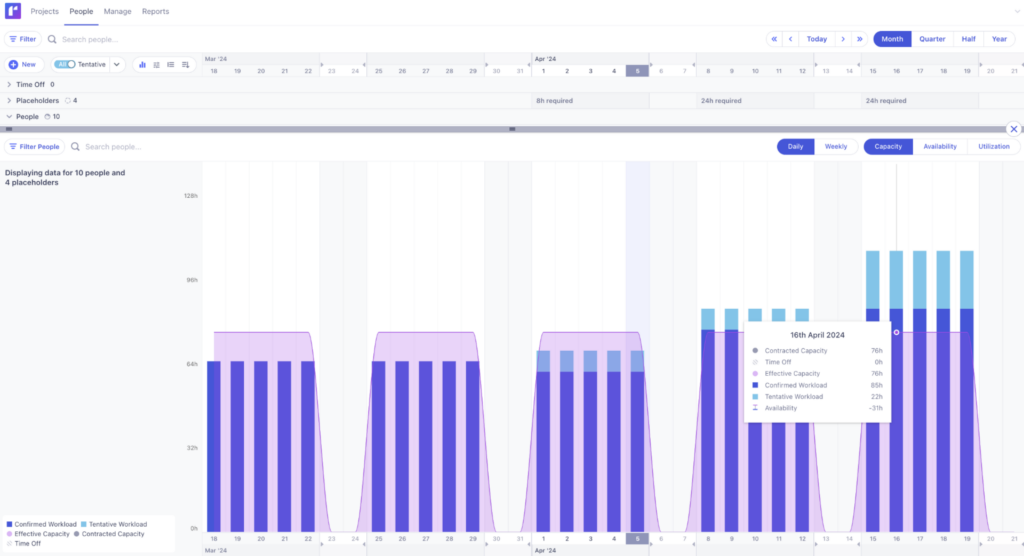Digital Marketing 101: A Starter Guide For Small Businesses On Amazon
Subhasree Nag, 9 hours ago

Capacity planning is a crucial aspect of managing resources effectively within an organization. It involves forecasting future demands for resources and ensuring that there are sufficient capabilities in place to meet these demands.
Capacity planning software is pivotal in this process by providing tools and insights to help organizations make informed decisions about their resource allocation. But what exactly is capacity planning software, and how does it work?
Capacity planning software is a specialized tool designed to help organizations forecast, manage, and optimize their resources. This type of software provides insights into current resource utilization and future demands, allowing businesses to plan and adjust their capacity accordingly.
Whether it’s for IT infrastructure, manufacturing, human resources, or other areas, capacity planning software helps ensure that resources are used efficiently and effectively.
By using capacity planning software, organizations can avoid underutilizing or overdoing their resources, leading to inefficiencies and increased costs.
Capacity planning software operates through several key processes that involve data collection, analysis, and optimization. Here’s a detailed look at how this software functions:
The first step in capacity planning is gathering relevant data. This includes historical data on resource usage, current utilization rates, and any other factors that could impact resource needs.
Effective data collection ensures that the software has accurate and comprehensive information to work with, which is essential for making precise forecasts and decisions.
Once data is collected, capacity planning software uses various analytical methods to forecast future resource requirements. This process helps organizations anticipate demand and prepare accordingly.
Forecasting and analysis enable organizations to plan proactively, reducing the risk of resource shortages or excesses.

With forecasts in hand, capacity planning software helps organizations allocate resources effectively to meet anticipated demand. This involves making strategic decisions about where and how resources should be deployed.
Effective resource allocation ensures that the organization is prepared to meet demand without unnecessary expenditures or disruptions.
Capacity planning software provides tools for ongoing monitoring and reporting to ensure that resources are used as planned and to identify any deviations from the forecast.

Regular monitoring and reporting help organizations stay on track with their capacity plans and make informed adjustments as needed.
Implementing capacity planning software offers several benefits, including:
Capacity planning software helps an organization use its resources by forecasting upcoming needs and with the help of resource allocation. It allows the organization to use the resources more efficiently, reduces waste, and improves overall productivity.
Effective capacity planning also reduces the risk of under-provisioning or over-provisioning resources, and this helps save costs. This way, an organization can avoid any unnecessary expenditure on surplus resources and reduce the cost associated with resource shortages.
With exact forecasts and comprehensive data analysis, the decision-makers can make better and more informed decisions about where they need to allocate more resources and plan better. This helps in making better strategic decisions and also improves operational performance.
Capacity planning software allows organizations to adapt to the changes that the market is currently looking for quickly. Evaluating different scenarios and adjusting to the plans helps a business stay responsive and agile.
The software gets you valuable insights into performance and resource utilization, enabling a company to detect potential issues ahead of time, monitor progress, and make data-driven decisions. It provides real-time visibility into how resources are allocated and utilized.
It also helps to make sure that the project is on track and that any kind of bottlenecks are addressed immediately. This level of transparency allows for proactive adjustments, improving operational efficiency and optimizing overall performance.
This is an important tool for those organizations that are looking for ways to manage their resources effectively and efficiently. It collects and analyzes data, looks after the needs ahead of time, optimizes the allocated resources, and provides ongoing reporting and monitoring.
It helps businesses avoid resource-related challenges and make informed decisions. Implementing this software improves efficiency, saves money, helps make better decisions, increases flexibility, improves visibility, and supports the sustainability and long-term success of the organization.
Read Also:
A self-proclaimed Swiftian, Instagram-holic, and blogger, Subhasree eats, breathes, and sleeps pop culture. When she is not imagining dates with Iron Man on Stark Tower (yes, she has the biggest crush on RDJ, which she won’t admit), she can be seen tweeting about the latest trends. Always the first one to break viral news, Subhasree is addicted to social media, and leaves out no opportunity of blogging about the same. She is our go-to source for the latest algorithm updates and our resident editor.